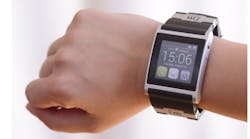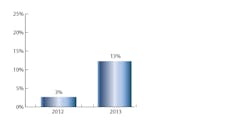Wearable technology is all the rage in consumer electronics circles these days. This is especially true on the health-and-fitness front, as interest in purchasing wearable electronic fitness devices over the next 12 months has quadrupled in the last year, according to the Consumer Electronics Association (CEA).
In a mid-December report, the CEA said consumer interest in purchasing dedicated wearable fitness devices in the next 12 months grew to 13% in 2013, up from just 3% in 2012. This is the largest year-over-year increase for any category of fitness device, the group said in its new study Understanding the Market for Wearable Health and Fitness Devices. What’s more, ownership of dedicated wearable fitness devices tripled in 2013, reaching 9% compared to 3% in 2012.
“CEA projects that the market for dedicated wearable fitness devices like body monitors and pedometers will continue to expand for the foreseeable future as more consumers become aware of these devices and an array of new products enters the market,” Kevin Tillmann, senior research analyst for CEA said in announcing the study’s findings in December.
Consumers list motivation and the ability to monitor both fitness goals and their physical activity levels or intensity as key reasons for driving their interest in wearable fitness devices. Seventy-five percent of U.S. consumers say they own a fitness technology product, up from 61% in 2012. Pedometers are the most popular product, followed by fitness video games and portable blood-pressure monitors. Looking ahead, CEA says dedicated wearable fitness devices, fitness apps, fitness video games, and calorie trackers will be most in demand.
And as demand grows, sales of fitness and activity-tracking devices are expected to exceed $1 billion this year—a nearly 40% increase over 2013.
“Fitness technology owners indicate they are seeing personal progress in their overall health and/or on specific goals, such as losing weight or lowering blood pressure, using their devices as much or even more than they originally expected,” Tillmann says. “Not only are these fitness technology products catching on in the marketplace and experiencing strong growth in sales, consumers indicate they are experiencing positive results as well.”
Gartner Research predicts similar growth in wearable fitness devices over the next few years. Worldwide revenue from wearable electronic devices, apps, and services for fitness and personal health was expected to reach $1.6 billion in 2013 on the way to $5 billion by 2016, according to Gartner’s research director Angela McIntyre. In a December outlook on wearable technology, McIntyre predicted ongoing strength in the wearable electronics market for fitness and health, noting that it’s part of a larger social trend.
“Wearables support the ‘quantified self’ trend of people tracking their vital signs, activities, and capturing images of what they experience during the day,” McIntyre explains. “The fun of wearing and using gadgets to track fitness and health is appealing, and so is using their apps and services. Gamification enables wearers to compete against themselves or others and rewards wearers. Online communities provide camaraderie with those having similar goals. Wearable electronics provide new motivation to consumers for improving fitness and health.”









